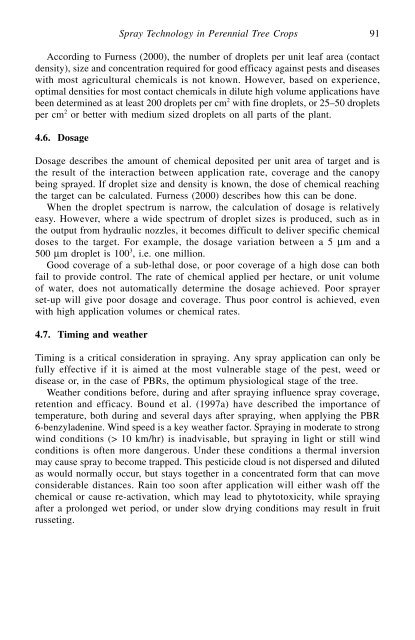Production Practices and Quality Assessment of Food Crops. Vol. 1
Production Practices and Quality Assessment of Food Crops. Vol. 1
Production Practices and Quality Assessment of Food Crops. Vol. 1
Create successful ePaper yourself
Turn your PDF publications into a flip-book with our unique Google optimized e-Paper software.
According to Furness (2000), the number <strong>of</strong> droplets per unit leaf area (contact<br />
density), size <strong>and</strong> concentration required for good efficacy against pests <strong>and</strong> diseases<br />
with most agricultural chemicals is not known. However, based on experience,<br />
optimal densities for most contact chemicals in dilute high volume applications have<br />
been determined as at least 200 droplets per cm 2 with fine droplets, or 25–50 droplets<br />
per cm 2 or better with medium sized droplets on all parts <strong>of</strong> the plant.<br />
4.6. Dosage<br />
Dosage describes the amount <strong>of</strong> chemical deposited per unit area <strong>of</strong> target <strong>and</strong> is<br />
the result <strong>of</strong> the interaction between application rate, coverage <strong>and</strong> the canopy<br />
being sprayed. If droplet size <strong>and</strong> density is known, the dose <strong>of</strong> chemical reaching<br />
the target can be calculated. Furness (2000) describes how this can be done.<br />
When the droplet spectrum is narrow, the calculation <strong>of</strong> dosage is relatively<br />
easy. However, where a wide spectrum <strong>of</strong> droplet sizes is produced, such as in<br />
the output from hydraulic nozzles, it becomes difficult to deliver specific chemical<br />
doses to the target. For example, the dosage variation between a 5 µm <strong>and</strong> a<br />
500 µm droplet is 100 3 , i.e. one million.<br />
Good coverage <strong>of</strong> a sub-lethal dose, or poor coverage <strong>of</strong> a high dose can both<br />
fail to provide control. The rate <strong>of</strong> chemical applied per hectare, or unit volume<br />
<strong>of</strong> water, does not automatically determine the dosage achieved. Poor sprayer<br />
set-up will give poor dosage <strong>and</strong> coverage. Thus poor control is achieved, even<br />
with high application volumes or chemical rates.<br />
4.7. Timing <strong>and</strong> weather<br />
Spray Technology in Perennial Tree <strong>Crops</strong> 91<br />
Timing is a critical consideration in spraying. Any spray application can only be<br />
fully effective if it is aimed at the most vulnerable stage <strong>of</strong> the pest, weed or<br />
disease or, in the case <strong>of</strong> PBRs, the optimum physiological stage <strong>of</strong> the tree.<br />
Weather conditions before, during <strong>and</strong> after spraying influence spray coverage,<br />
retention <strong>and</strong> efficacy. Bound et al. (1997a) have described the importance <strong>of</strong><br />
temperature, both during <strong>and</strong> several days after spraying, when applying the PBR<br />
6-benzyladenine. Wind speed is a key weather factor. Spraying in moderate to strong<br />
wind conditions (> 10 km/hr) is inadvisable, but spraying in light or still wind<br />
conditions is <strong>of</strong>ten more dangerous. Under these conditions a thermal inversion<br />
may cause spray to become trapped. This pesticide cloud is not dispersed <strong>and</strong> diluted<br />
as would normally occur, but stays together in a concentrated form that can move<br />
considerable distances. Rain too soon after application will either wash <strong>of</strong>f the<br />
chemical or cause re-activation, which may lead to phytotoxicity, while spraying<br />
after a prolonged wet period, or under slow drying conditions may result in fruit<br />
russeting.

















